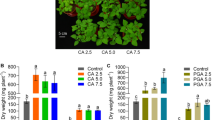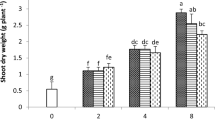Abstract
This study focused on the effects of different mineral supplements on the ability of Corynebacterium glutamicum to degrade phenol in contaminated soil and convert the phenol into useful amino acids. Three types of minerals including FeSO4, MgSO4, and MnSO4 were added at several concentrations to C. glutamicum culture media containing 1% yeast extract prior to treating the soil samples with 4.24 mM phenol. The reactor was incubated at 30°C and 150 rpm for 3 days, and the treated soil was sampled daily and analyzed using gas chromatography for residual phenol and the amino acids produced. Additionally, a plant toxicity assay was employed to examine the fertilization of the phenol-contaminated soil after C. glutamicum treatment supplemented with the three minerals. Our results suggested that among various tested concentrations, 72 μM of iron showed a significant effect on the utilization of phenol by C. glutamicum for conversion to amino acids, therefore enhancing fertilization of the phenol-contaminated soil.
Similar content being viewed by others
References
Nardi, A., R. Avrahami, E. Zussman, J. S. Rokem, and C. L. Greenblatt (2012) Phenol biodegradation by Corynebacterium glutamicum encapsulated in electrospun fibers. J. Environ. Protection. 3: 164–168.
Abdullah-Al-Mahin, A. Z. C., M. K. Alam, Z. Aktar, and A. Fakhruddin (2011) Phenol biodegradation by two strains of Pseudomonas putida and effect of lead and zinc on the degradation process. Int. J. Environ. 1: 27–33.
Diaz, E. (2004) Bacterial degradation of aromatic pollutants: A paradigm of metabolic versatility. Int. Microbiol. 7: 173–180.
Klein, J. (2000) Possibilities, limits and future developments of soil bioremediation. 2nd ed., pp. 465–476. Biotechnology Set. John Wiley and Sons.
Sabaté, J., M. Vinas, and A. Solanas (2004) Laboratory-scale bioremediation experiments on hydrocarbon-contaminated soils. Int. Biodeter. Biodegr. 54: 19–25.
Hamitouche, A., A. Amrane, Z. Bendjama, and F. Kaouah (2010) Effect of the Ammonium chloride concentration on the mineral medium composition — biodegradation of phenol by a microbial consortium. Int. J. Environ. Res. 4: 849–854.
Thomas, S., S. Sarfaraz, L. C. Mishra, and L. Iyengar (2002) Degradation of phenol and phenolic compounds by a defined denitrifying bacterial culture. World J. Microb. Biot. 18: 57–63.
Brinkrolf, K., I. Brune, and A. Tauch (2006) Transcriptional regulation of catabolic pathways for aromatic compounds in Corynebacterium glutamicum. Genet. Mol. Res. 5: 773–789.
Kinoshita, S., S. Udaka, and M. Shimono (2004) Studies on the amino acid fermentation — Part I. Production of L-glutamic acid by various microorganisms. J. Gen. Appl. Microbiol. 50: 331–343.
Shen, X. H., Y. Huang, and S. -J. Liu (2005) Genomic analysis and identification of catabolic pathways for aromatic compounds in Corynebacterium glutamicum. Microb. Environ. 20: 160–167.
Shen, X. H., Z. P. Liu, and S. J. Liu (2004) Functional identification of the gene locus (ncg12319 and characterization of catechol 1,2-dioxygenase in Corynebacterium glutamicum. Biotechnol. Lett. 26: 575–580.
Lee, S. Y., T. H. Le, S. T. Chang, J. S. Park, Y. H. Kim, and J. Min (2010) Utilization of phenol and naphthalene affects synthesis of various amino acids in Corynebacterium glutamicum. Curr. Microbiol. 61: 596–600.
Shen, X. H., N. Y. Zhou, and S. J. Liu (2012) Degradation and assimilation of aromatic compounds by Corynebacterium glutamicum: Another potential for applications for this bacterium? Appl. Microbiol. Biot. 95: 77–89.
Wieschalka, S., B. Blombach, and B. J. Eikmanns (2012) Engineering Corynebacterium glutamicum for the production of pyruvate. Appl. Microbiol. Biot. 94: 449–459.
Lee, S. Y., B. N. Kim, Y. W. Choi, K. S. Yoo, Y. H. Kim, and J. Min (2012) Growth response of avena sativa in amino-acids-rich soils converted from phenol-contaminated soils by Corynebacterium glutamicum. J. Microbiol. Biotechnol. 22: 541–546.
Chang, L. W., J. R. Meier, and M. K. Smith (1997) Application of plant and earthworm bioassays to evaluate remediation of a lead-contaminated soil. Arch. Environ. Con. Tox. 32: 166–171.
Chen, B. Y., J. W. You, and J. S. Chang (2009) Optimal exponential feeding strategy for dual-substrate biostimulation of phenol degradation using Cupriavidus taiwanensis. J. Hazard Mater. 168: 507–514.
Lee, S. Y., Y. H. Kim, and J. Min (2010) Conversion of phenol to glutamate and proline in Corynebacterium glutamicum is regulated by transcriptional regulator ArgR. Appl. Microbiol. Biot. 85: 713–720.
Sayles, G. D., C. M. Acheson, M. J. Kupferle, Y. Shan, Q. Zhou, J. R. Meier, L. Chang, and R. C. Brenner (1999) Land treatment of PAH contaminated soil: Performance measured by chemical and toxicity assays. Environ. Sci. Technol. 33: 4310–4317.
Le, T. H., S. J. Kim, S. H. Bang, S. H. Lee, Y. W. Choi, P. Kim, Y. H. Kim, and J. Min (2012) Phenol degradation activity and reusability of Corynebacterium glutamicum coated with NH2-functionalized silica-encapsulated Fe3O4 nanoparticles. Bioresour. Technol. 104: 795–798.
Moreira, I. S., C. L. Amorim, M. F. Carvalho, A. C. Ferreira, C. M. Afonso, and P. M. L. Castro (2013) Effect of the metals iron, copper and silver on fluorobenzene biodegradation by Labrys portucalensis. Biodegradat. 24: 245–255.
Aldric, J. -M., J. Destain, and P. Thonart (2003) Study of some factors influencing biodegradation of isopropylbenzene by Rhodococcus erythropolis. Proceedings of the Environment 2010: Situation and Perspectives for the European Union. Porto, Portugal.
Santos, E. C., R. J. S. Jacques, F. M. Bento, M. D. R. Peralba, P. A. Selbach, E. L. S. Sa, and F. A. O. Camargo (2008) Anthracene biodegradation and surface activity by an iron-stimulated Pseudomonas sp. Bioresour. Technol. 99: 2644–2649.
Lin, C. W., S. Y. Chen, and Y. W. Cheng (2006) Effect of metals on biodegradation kinetics for methyl tert-butyl ether. Biochem. Eng. J. 32: 25–32.
Lee, S. Y., H. S. Shin, J. S. Park, Y. H. Kim, and J. Min (2010) Proline reduces the binding of transcriptional regulator ArgR to upstream of argB in Corynebacterium glutamicum. Appl. Microbiol. Biot. 86: 235–242.
Author information
Authors and Affiliations
Corresponding author
Rights and permissions
About this article
Cite this article
Kim, BN., Le, TH., Hong, E. et al. Effects of different mineral supplements on fertilization of phenol-contaminated soils by Corynebacterium glutamicum . Biotechnol Bioproc E 19, 276–281 (2014). https://doi.org/10.1007/s12257-013-0768-4
Received:
Revised:
Accepted:
Published:
Issue Date:
DOI: https://doi.org/10.1007/s12257-013-0768-4




